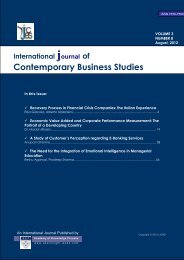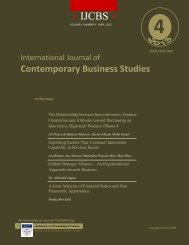International journal of Contemporary Business Studies
International journal of Contemporary Business Studies
International journal of Contemporary Business Studies
Create successful ePaper yourself
Turn your PDF publications into a flip-book with our unique Google optimized e-Paper software.
<strong>International</strong> Journal <strong>of</strong> <strong>Contemporary</strong> <strong>Business</strong> <strong>Studies</strong><br />
Vol: 3, No: 6. June, 2012 ISSN 2156-7506<br />
Available online at http://www.akpinsight.webs.com<br />
Study on some firms in Hong Kong investigated to get the relationship <strong>of</strong> source <strong>of</strong> stress with<br />
psychological distress, job satisfaction and intension <strong>of</strong> quitting from job is directly the outcome <strong>of</strong> locus<br />
<strong>of</strong> control and organizational commitment (Siu and Cooper, 1998). On the other hand, the study on staff<br />
and nurses in UK was made to investigate the staff turnover ratio, staff age and tenure and found that<br />
tenure is a strongly associated with job satisfaction (Gray et.al, 1994)<br />
3. METHOD<br />
In order to extract data on job satisfaction <strong>of</strong> employees the JDI (Job Description Index) was used. In<br />
1969, JDI was developed by Kendall, Smith and Hulin. According to Kreitner and Kinicki (1995) this is<br />
most widely used tool to measure staff overall job satisfaction. Spector (2000) found JDI the most reliable<br />
tool to measure Job satisfaction level <strong>of</strong> employees, and it help us to measure the different aspects <strong>of</strong> job<br />
satisfaction separately from each other. JDI want respondents to explain jobs they perform compare to ask<br />
direct question “How much satisfied you are” in order to ensure that person filling the questionnaire<br />
should provide feedback which is related to job rather than satisfaction in general. The Job Description<br />
Index measudeal with five aspects for job satisfaction perceptions, Salary or pay, chances for promotions,<br />
supervision staff get in <strong>of</strong>fice, <strong>of</strong>fice mates or co-workers and the job staff performs (Spector, 2000).<br />
Seventy two (72) items have been included in this measuring instrument out <strong>of</strong> which ,nine (9) items are<br />
used for each aspect <strong>of</strong> promotion and pay, and eighteen (18) items each for work, supervision, and coworkers<br />
(Smucker & Kent, 2004). In order to get total score <strong>of</strong> the responses, employees are requested to<br />
specify whether each statement does or does not explain their jobs. The score <strong>of</strong> responses is measured as<br />
(yes) = 3, (?) = 1 and (no) = 0 for positive items, whereas (yes) = 0, (?) = 1, and (no) = 3 used for negative<br />
items (Cherrington, 1994). Job satisfaction level is related with the overall score, Satisfaction will be as<br />
high as the score (Kreitner & Kinicki, 2001). All questionnaires were distributed through post and emails.<br />
In order to find relationship among rank, age, gender and tenure with overall job satisfaction, The<br />
Multiple Regression Model was used.<br />
Overall Job Satisfaction (OJS) = β 0 +β 1 rank+β 2 gender+β 3 length+β 4 age+ ε<br />
4. DISCUSSION OF RESULTS<br />
Table 1Dimensions <strong>of</strong> Job Satisfaction – Descriptive Statistics<br />
Frequency Minimum Maximum Mean Value Standard Deviation<br />
Job 191 15 45 39.01 5.842<br />
Pay 191 5 32 16.52 5.926<br />
Supervision 191 12 45 33.59 6.014<br />
Promotion 191 5 23 13.87 2.310<br />
People 191 9 48 29.66 9.554<br />
Valid N (list<br />
wise)<br />
191<br />
Faculty members are satisfied with the nature <strong>of</strong> work (mean = 39.01), coworkers (mean = 29.66) as well<br />
as the supervision (mean =33.59) they get in their institute. The mean values <strong>of</strong> pay and promotion<br />
subscales were 16.52 and 13.87 respectively, both values reflects that our respondents are less satisfied<br />
with pay they receive and the chances <strong>of</strong> promotion they get in their institutes.<br />
Copyright © 2012. Academy <strong>of</strong> Knowledge Process<br />
19
















